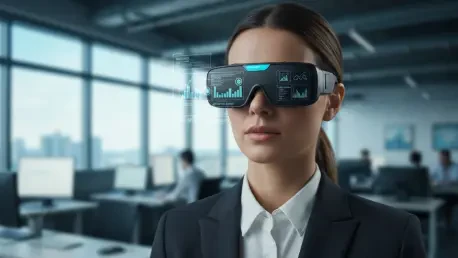Imagine a scenario where a critical machine breaks down on a factory floor, the client is pressing for a quick resolution, and the nearest expert is thousands of miles away, unable to assist in person. A technician dons a pair of augmented reality (AR) smart glasses, connects instantly with the specialist, and sees real-time annotations guiding the repair process right in their field of view. The issue is resolved in minutes, saving hours of downtime and costly delays. This isn’t a distant dream but a tangible reality that AR smart glasses are bringing to businesses today. As a pivotal endpoint in unified communications, these devices are poised to redefine how industries operate by enabling hands-free collaboration, slashing training times, and enhancing customer interactions. Market projections indicate that AI-driven smart glasses alone could be valued at $3.01 billion by 2032, with shipments of extended reality (XR) technology to enterprises already gaining momentum. The stage is set for a transformative shift, and by 2026, these tools are expected to be integral to business strategies across sectors.
1. The Current Leap in AR Smart Glass Technology
Significant strides in AR smart glass technology are evident this year, marking a turning point for their practical application in business environments. Platforms like Samsung’s Galaxy XR, alongside upcoming collaborations between Google and Samsung, are delivering lighter, more efficient devices that offload heavy processing to connected smartphones. This integration creates a seamless experience, linking mobile tools, collaboration software, and spatial data into a unified workflow. Edge computing and on-device AI further enhance functionality by offering real-time speech translation, part identification, and workflow instructions, making these glasses indispensable for dynamic work settings. Compatibility with popular platforms like Teams, Zoom, and Webex is now a top priority for enterprise adoption, ensuring that businesses can embed this technology into existing systems without disruption.
Beyond hardware advancements, industry adoption is accelerating as companies recognize the value of AR glasses for communication and training. Firms across logistics, manufacturing, and tech sectors are deploying solutions from providers like Meta and Varjo to streamline operations. Even major players like Apple are entering the fray with business-oriented wearables such as Vision Air, signaling a broader acceptance of AR as a core tool. This convergence of innovation and application underscores a shift from experimental phases to strategic integration, positioning AR smart glasses as a cornerstone of modern business infrastructure by the middle of this decade.
2. Operational Efficiency and Cost Reduction with AR Glasses
One of the standout benefits of AR smart glasses lies in their ability to drive operational efficiency while significantly cutting costs for businesses. Compared to other XR solutions, such as Apple’s spatial computing device priced at nearly $4,000, these glasses offer a more affordable entry point into immersive technology. They address high-cost pain points like travel and time inefficiencies head-on. For example, logistics giant DHL reported a 25% increase in warehouse picking efficiency and a sharp drop in error rates after implementing Vuzix head-mounted displays. Similarly, field service teams using Samsung’s Galaxy XR platform have reduced average repair times by 30 to 40%, simply by enabling technicians to share live visuals with remote experts instead of relying on verbal descriptions.
This technology merges frontline execution with remote collaboration, creating measurable savings across industries. Automotive plants utilizing Vuzix and NSFlow systems have seen maintenance teams complete inspections without leaving the production line, eliminating unnecessary downtime. The hands-free nature of AR glasses, paired with integration into familiar tools like Teams or Webex, allows engineers to receive real-time guidance without stepping away from critical tasks. As a result, businesses can minimize repeat visits, reduce travel expenses, and optimize resource allocation, making AR glasses a cost-effective solution for operational challenges in high-stakes environments.
3. Enhancing Collaboration and Communication
AR smart glasses are revolutionizing how teams communicate by closing gaps that often hinder productivity in dispersed workforces. These devices enable a shared real-time experience, allowing a remote manager to view a factory floor through a technician’s perspective and provide live annotations on equipment. Features like instant translation and speech rendering further break down language barriers, with tools such as Meta’s Ray-Ban Display glasses projecting captions and messages directly into the user’s line of sight. This creates a fluid, hands-free connection that feels intuitive and accessible, especially for teams spread across different time zones or locations.
Moreover, AR glasses are emerging as a vital “third interface” alongside phones and laptops, freeing workers from the constant need to juggle multiple screens. Accessibility features, including voice control and live captioning, ensure that all team members can engage effortlessly, regardless of physical or linguistic limitations. This inclusivity fosters a more connected workforce, enhancing collaboration in noisy or high-pressure settings. By embedding real-time context into everyday interactions, AR smart glasses are not just improving communication but also making it more human-centric, a critical factor for businesses aiming to maintain strong team dynamics in a hybrid world.
4. Accelerating Innovation and Time-to-Market
In fields like design and engineering, where speed often dictates competitive advantage, AR smart glasses are proving to be game-changers. These devices allow teams to visualize 3D prototypes, blueprints, and digital twins directly in their field of view, streamlining the creative process. Tools like XREAL One Pro glasses enable engineers to overlay CAD models for immediate comparison, identifying potential flaws before production begins. Automotive professionals using Vuzix devices can review schematics and conduct quality checks on-site, reducing the need for costly rework and accelerating project timelines.
The integration of AI in the latest AR glasses further enhances this capability by ensuring that digital visuals remain aligned with the user’s movements, providing a stable and precise workflow. Updates appear instantly, and design approvals can happen in real time, shaving hours or even days off development cycles. For industries where time-to-market is a critical metric, this precision translates into a tangible edge over competitors. By embedding such advanced visualization into daily operations, businesses can push innovation forward faster, ensuring that products reach customers sooner and with fewer iterations.
5. Boosting Productivity and Employee Performance
When critical information is delivered directly into a worker’s line of sight, productivity sees a remarkable uptick across various roles. Research from AREA highlights that AR-guided workflows can reduce failure rates by 70%, cut rework by 80%, and speed up procedures by 40%. Frontline staff equipped with smart glasses can access digital checklists, capture images, and connect with supervisors without losing focus on the task at hand. This seamless flow of data ensures that employees remain engaged in their work, minimizing distractions and errors in high-stakes environments like manufacturing or field service.
Hardware advancements are also removing traditional barriers to adoption, with devices like Samsung’s Galaxy XR headset and Meta’s Ray-Ban Display offering improved battery life, connectivity, and ergonomic design. These enhancements mean workers can use AR glasses for extended periods without discomfort, further supporting sustained performance. As the technology continues to evolve, the message remains consistent: equipping staff with real-time, hands-free information directly correlates with better outcomes. Businesses that prioritize such tools are likely to see not just productivity gains but also a more confident and capable workforce.
6. Elevating Customer Experience and Engagement
Modern customers expect swift, clear solutions, and AR smart glasses are uniquely positioned to meet these demands without adding complexity. Sales representatives can guide clients through intricate setups using live AR annotations, while support technicians can visually demonstrate fixes to remote customers. Retailers leveraging AR visualization tools have reported impressive results, with REYDAR data indicating that 3D and AR product views can boost online conversion rates by as much as 94%. This technology transforms how businesses interact with their audience, making engagements more interactive and effective.
In-person customer interactions also benefit significantly from AR capabilities. Devices like Meta’s Ray-Ban Display glasses provide live captions and translations during conversations, eliminating communication barriers and fostering trust. For customer-facing teams, these tools enable more compelling demonstrations, reduce misunderstandings, and pave the way for quicker agreements. By integrating AR smart glasses into service and sales strategies, companies can create memorable experiences that resonate with clients, ultimately driving loyalty and satisfaction in an increasingly competitive market.
7. Revolutionizing Training and Workforce Development
Training bottlenecks pose a persistent challenge for many organizations, but AR smart glasses offer a powerful solution by transforming how skills are transferred. By overlaying digital instructions and providing live mentor guidance, these devices enable new hires to learn through hands-on experience rather than static manuals. A notable study by PwC found that participants trained with AR and VR completed their learning up to four times faster while retaining information more effectively, a testament to the immersive nature of this technology.
In sectors like manufacturing and healthcare, deployments of Vuzix and NSFlow systems allow experts to train multiple employees remotely by seeing exactly what each trainee sees in real time. This approach not only scales institutional knowledge efficiently but also cuts the costs and downtime associated with traditional classroom sessions. Mistakes are minimized before they impact customers, as learning happens directly on the job. For businesses, this means a faster ramp-up for new staff and a more skilled workforce overall, positioning AR glasses as a cornerstone of modern training programs.
8. Steps to Implement AR Smart Glasses Effectively
Implementing AR smart glasses requires a strategic approach to ensure adoption and impact, starting with a focused scope and clear objectives. Businesses should pinpoint a specific issue—such as excessive travel, onboarding delays, or warehouse errors—and define measurable goals like fewer repeat visits or faster task completion. A small-scale rollout targeting one pain point allows for manageable testing and refinement, building confidence in the technology before broader deployment. This initial step ensures that the value of AR glasses is proven in a real-world context, setting a foundation for wider integration.
Integration with existing systems is equally critical for seamless adoption. Modern AR glasses connect directly to familiar platforms like Teams, Zoom, or Webex, enabling technicians to share live video or capture records without interrupting workflows. Launching a targeted pilot with 10 to 20 devices within a single team keeps the process controlled, allowing for iterative feedback and quick adjustments to address pain points. Vodafone Business emphasizes this as demonstrating “everyday value,” ensuring the technology aligns with practical needs. Training also plays a vital role—brief, one-hour orientations paired with simple guides can ease the transition, while early adopters often become internal champions, driving enthusiasm across teams. Finally, tracking progress from the outset using concrete data helps refine rollouts, ensuring sustained benefits and continuous improvement.
9. Addressing Challenges in AR Smart Glass Rollouts
No technology deployment is without hurdles, and AR smart glasses are no exception, necessitating proactive management of common issues. Security remains a top concern, especially in regulated industries, making it essential to manage these devices through existing systems with features like remote wipe and app permissions. Clear privacy policies must be established to build trust among users and comply with legal standards. Addressing these control measures early prevents potential breaches and ensures that sensitive data remains protected during real-time collaborations.
Usability and hardware considerations also demand attention to guarantee widespread acceptance. Customizing settings like brightness, captions, and voice tools promotes inclusivity, allowing all employees to use the glasses confidently. Selecting hardware based on practical factors such as weight, battery life, and connectivity—rather than just brand recognition—ensures a better fit for specific team needs. Managing expectations is equally important; while the technology is advancing rapidly, success hinges on effective change management. A straightforward approach—starting small, integrating thoughtfully, measuring frequently, and highlighting meaningful wins—paves the way for a smooth rollout and lasting impact.
10. Looking Ahead to Mainstream Adoption
Reflecting on recent progress, it’s clear that AR smart glasses have reached a maturity point by this year, with hardware becoming lighter, faster, and more suited for everyday business tasks. Major industry players like Meta with their Ray-Ban Display, Samsung and Google’s Galaxy XR collaboration, and Apple’s forthcoming Vision Air demonstrate a commitment to building robust platforms rather than mere prototypes. Subscription models bundling hardware, software, and analytics under predictable costs have emerged as a trend, simplifying budgeting and ensuring access to the latest upgrades for enterprises.
Looking toward 2026 and 2027, the trajectory suggests that AR smart glasses are on the cusp of becoming mainstream tools across industries. Companies that have initiated pilots in these formative stages find themselves ahead, having refined strategies and trained teams to leverage the technology effectively. For business leaders, the path forward involves taking decisive action—starting with small-scale trials, analyzing data rigorously, and embedding AR glasses into unified communications plans. Those who act promptly gain early access to deeper benefits, positioning their organizations to thrive in a landscape where immersive tech has become not just an advantage, but a necessity.









